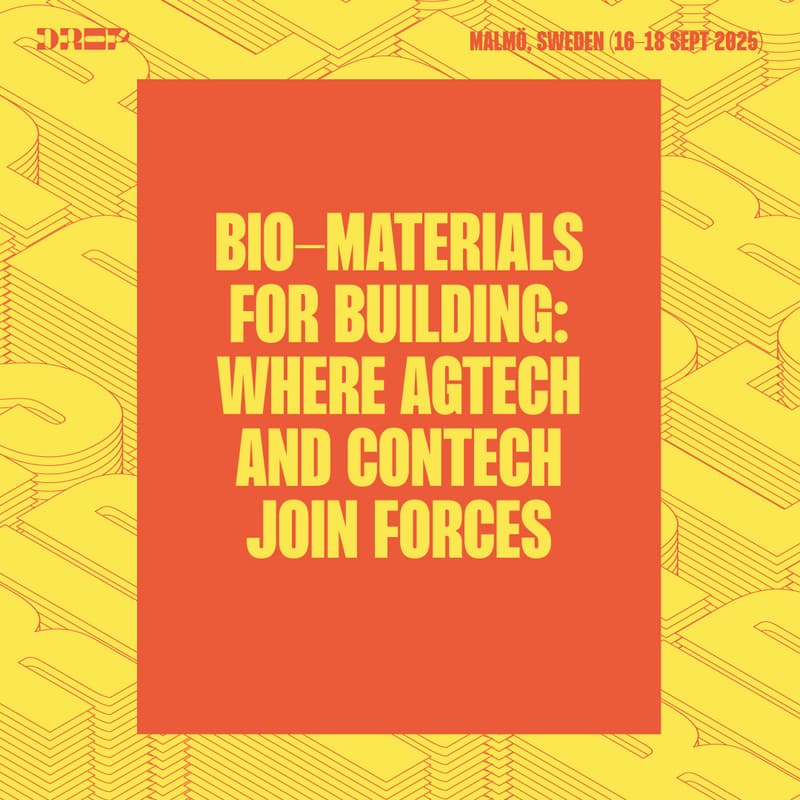

Bio-materials for building: where AgTech and ConTech join forces
Ripple Hosts
Patricia De Esteban Belzuz
Cardumen Capital
Marius Weckel
Kopa Ventures
TL;DR
This roundtable dives into the promise and pitfalls of bio-materials in construction, where AgTech meets ConTech. Together, investors, founders, and industry leaders will debate the ethical, economic, and social trade-offs of scaling production, explore breakthrough technologies and business models, and challenge each other on what it will really take for bio-materials to compete with steel and concrete. Expect a lively, polemical discussion designed to spark ideas, sharpen theses, and build connections.
Topic overview
Why is the topic relevant?
There is a clear need for low-carbon, high-performing building materials. Bio-based alternatives for insulation and even some load-bearing applications can provide an economically viable and technically feasible solution to this issue, bringing some interesting properties that conventional materials do not possess. In hindsight, global demand for food is expected to grow by 50% by 2050, creating a controversy over land-use in agriculture to grow crops for materials vs food. In this ripple, we explore the trade-offs between of bio-materials in construction and agriculture, technologies and strategies that can minimize the impacts on both sides, the applications and benefits of bio-materials, and core challanges in deploying bio-based alternatives (ie code compliance, unit economics, supply chains, etc)
What’s up for discussion?
Land vs. Buildings: The trade-offs between dedicating crops to construction versus food.
Tech Fixes: Which agricultural and material technologies (robotics, gene-editing, automation, advanced processing) can minimize impacts on both sides?
Biomaterial Farming: When does it make sense (rotations, byproducts, degraded land) — and when does it become harmful (clearing intact forests, displacing prime farmland)?
Decoupling Growth: How can we grow biomaterials without growing land use? Which strategies hold the most promise, and what barriers could block them?
Policy Provocations: Should all temporary buildings be required to use compostable biomaterials?
AI’s Role: How will AI affect design, testing, and performance optimization to make biomaterials realistic competitors to concrete and steel?
Applications & Benefits: Where biomaterials outperform (insulation, fire safety, carbon storage) and unconventional use cases (data centers, cooling, modular builds).
Core Challenges: Building codes, unit economics, supply chains, and perception barriers slowing mainstream adoption.
Land & Strategy: How should industrial strategy shape the balance between biomass cultivation, food production, and construction demand?
Dream outcome
Attendees leave with a clear-eyed understanding of the trade-offs — ethical, economic, and social — that come with scaling bio-materials for construction. They will walk away with:
New perspectives on when and where bio-materials make sense in the built environment, including edge cases beyond housing (data centers, cooling, infrastructure).
Practical insights into optimizing cost bases — from smarter feedstock strategies to efficient production models and resilient supply chains.
Investor takeaways that sharpen their thesis: which opportunities are scalable, which are risky, and where the most value can be captured.
Founder lessons on the core barriers — regulatory, financial, and supply chain — that must be solved to design truly scalable, investable businesses.
Corporate and developer insights into how to integrate bio-materials into projects today, balancing performance, risk, and long-term carbon goals.
Above all, the session will be a lively, polemical forum: not a monologue, but a collision of perspectives where investors, innovators, and industry leaders challenge each other, exchange ideas, and form connections that can drive the next wave of collaboration in AgTech–ConTech.
Who should attend?
A sustainability lead or architect from real estate or infrastructure developer, investors or corporates with knowledge of cost-benefit analysis of low-carbon materials, founders of bio-material and AgTech startups, experts on biomass supply chains as well as agricultural land use policies. Investors in the built environment and technology for agriculture.